This thread is to get us familiar with some of the terms that will be used in the post game film analysis threads. All the concepts and terminology mentioned in this thread can be found on the web in case more info is wanted.
Film Threads
2014
@DAL vsCHI @ARI vsPHI vsKC @STL @DEN vsSTL @NO @NYG vsWAS vsSEA @OAK @SEA vsSD vsARI
2015
vsMIN @PIT @ARI vsGB @NYG vsBAL vsSEA @STL vsATL @SEA vsARI @CHI vsSTL
2016
vsLAR @CAR @SEA vsDAL vsARI @BUF vsTBY
2017 Film Thread
2018 Film Thread
2019 Film Thread
There are 210 users in the forums
All22 Analysis - Coverages & Concepts
Apr 24, 2015 at 9:12 AM
- thl408
- Moderator
- Posts: 32,353
Apr 24, 2015 at 9:12 AM
- thl408
- Moderator
- Posts: 32,353
Zone Coverage: Cover 2 Zone, Tampa 2, Cover 3, Cover 4
The field is normally divided into six underneath zones - flat, curl, hook, hook, curl, flat. The deep zones are divided into halves, thirds, or fourths, depending on the number of deep zone defenders assigned by the coverage call.
Spot Drop Zone is where a zone defender drops back to his assigned landmark on the field with his eyes on the QB. He is responsible for any route that comes into his area, while not leaving his area.
Strengths:
- Easy to read run/pass because eyes are on the QB/offensive backfield
- Ability to react to the pass, gang tackle the ball carrier, because more eyes are facing the play
- Defends crisscrossing routes
Weaknesses:
- More windows for routes to become open; soft (quiet) spots between zones
- Defenders can be covering grass and be a non-factor on the play if there is no threat to his zone
- If the pass rush does not quickly apply pressure, zones begin to stretch and defenders have more area to cover
- Zones can be stretched and/or flooded to create an outnumbering situation

_____________________________________________________
Man Coverage: Cover 0, Cover 1, Cover 2 Man
An offense can send out a maximum of five route runners. If a defense decides to play man coverage, five defenders are assigned to each eligible receiver. Assuming a standard four man pass rush, this allows the defense to have two 'free' defenders to be utilized in any way the defensive coordinator chooses: blitz, double team a WR, play zone, etc.
Strengths:
- Advantage in athleticism by the defender can result in the WR never gaining separation
- Ability to blitz and have each route runner accounted for
Weaknesses:
- Difficult to get run/pass read if eyes are locked on a WR at the snap (press alignment)
- WRs can gain more run after catch yards because defenders in man coverage don't know when the ball is thrown
- QB scrambles because defenders' backs are turned to the QB
- Difficult to disguise pre-snap when a WR goes in motion
- Pick/rub route combinations
_____________________________________________________
Pattern Matching (pattern reading, match zone)
This coverage concept starts off as zone coverage, then morphs to man coverage as the play develops. The premise is that an offense has a finite amount of ways it can distribute routes throughout the field of play. Using pre-snap audibles and on-the-fly adjustments, a defense can cover any route while using the defender that is in the best position on the field to cover that route. It attempts to blend the best of both worlds from zone and man coverage. The origin of Pattern Matching came from Bill Belichick and Nick Saban when the two were in CLE where Belichick was the HC and Saban the DC.
Strengths:
- Tighter windows to throw into
- Defenders are less likely to cover grass as the coverage morphs to man coverage
- Ability to play split coverages to confuse the QB
- Can be incorporated into any cover shell (Cover 1/2/3/4)
Weaknesses:
- Difficult to teach on a team wide scale
- Blown coverages result in WRs running wide open
- Mismatches in coverage (safeties/LBs covering WRs)
- Late pre-snap motion/shifts can confuse pattern matching rules
The field is normally divided into six underneath zones - flat, curl, hook, hook, curl, flat. The deep zones are divided into halves, thirds, or fourths, depending on the number of deep zone defenders assigned by the coverage call.
Spot Drop Zone is where a zone defender drops back to his assigned landmark on the field with his eyes on the QB. He is responsible for any route that comes into his area, while not leaving his area.
Strengths:
- Easy to read run/pass because eyes are on the QB/offensive backfield
- Ability to react to the pass, gang tackle the ball carrier, because more eyes are facing the play
- Defends crisscrossing routes
Weaknesses:
- More windows for routes to become open; soft (quiet) spots between zones
- Defenders can be covering grass and be a non-factor on the play if there is no threat to his zone
- If the pass rush does not quickly apply pressure, zones begin to stretch and defenders have more area to cover
- Zones can be stretched and/or flooded to create an outnumbering situation

_____________________________________________________
Man Coverage: Cover 0, Cover 1, Cover 2 Man
An offense can send out a maximum of five route runners. If a defense decides to play man coverage, five defenders are assigned to each eligible receiver. Assuming a standard four man pass rush, this allows the defense to have two 'free' defenders to be utilized in any way the defensive coordinator chooses: blitz, double team a WR, play zone, etc.
Strengths:
- Advantage in athleticism by the defender can result in the WR never gaining separation
- Ability to blitz and have each route runner accounted for
Weaknesses:
- Difficult to get run/pass read if eyes are locked on a WR at the snap (press alignment)
- WRs can gain more run after catch yards because defenders in man coverage don't know when the ball is thrown
- QB scrambles because defenders' backs are turned to the QB
- Difficult to disguise pre-snap when a WR goes in motion
- Pick/rub route combinations
_____________________________________________________
Pattern Matching (pattern reading, match zone)
This coverage concept starts off as zone coverage, then morphs to man coverage as the play develops. The premise is that an offense has a finite amount of ways it can distribute routes throughout the field of play. Using pre-snap audibles and on-the-fly adjustments, a defense can cover any route while using the defender that is in the best position on the field to cover that route. It attempts to blend the best of both worlds from zone and man coverage. The origin of Pattern Matching came from Bill Belichick and Nick Saban when the two were in CLE where Belichick was the HC and Saban the DC.
Strengths:
- Tighter windows to throw into
- Defenders are less likely to cover grass as the coverage morphs to man coverage
- Ability to play split coverages to confuse the QB
- Can be incorporated into any cover shell (Cover 1/2/3/4)
Weaknesses:
- Difficult to teach on a team wide scale
- Blown coverages result in WRs running wide open
- Mismatches in coverage (safeties/LBs covering WRs)
- Late pre-snap motion/shifts can confuse pattern matching rules
Apr 24, 2015 at 9:13 AM
- thl408
- Moderator
- Posts: 32,353
Cover 0 - Middle of Field Open
(man coverage, 6+ blitz pressure)
Strengths:
- Can send heavy pressure and have each WR accounted for
- Defend inside run
Weaknesses:
- No safety help
- Run support at second level
- CBs playing press, no over-the-top help
- CBs playing with a cushion, no underneath help on crossing routes, slants
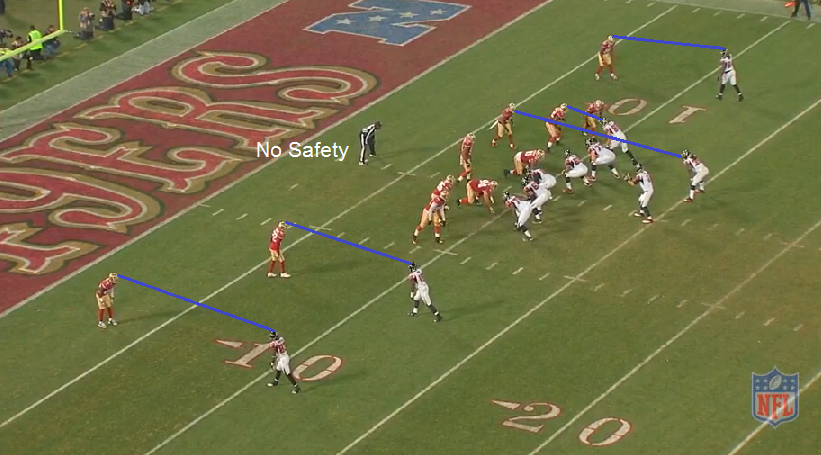
Bringing max pressure assures that there is one unblocked blitzer. 5 in coverage + 6 blitzers versus 5 blockers + 5 routes + QB. If a defender's man coverage assignment stays in to pass block, that defender has the option to blitz.
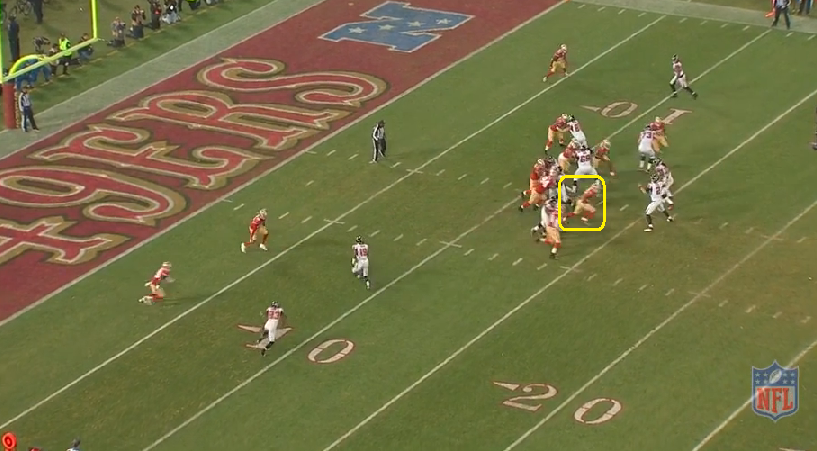
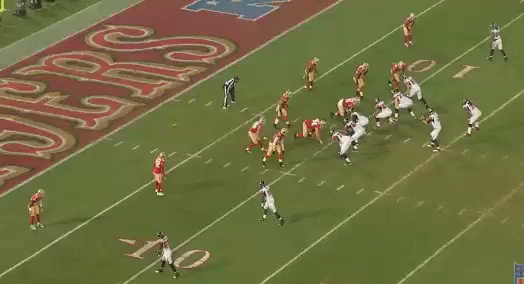
(man coverage, 6+ blitz pressure)
Strengths:
- Can send heavy pressure and have each WR accounted for
- Defend inside run
Weaknesses:
- No safety help
- Run support at second level
- CBs playing press, no over-the-top help
- CBs playing with a cushion, no underneath help on crossing routes, slants

Bringing max pressure assures that there is one unblocked blitzer. 5 in coverage + 6 blitzers versus 5 blockers + 5 routes + QB. If a defender's man coverage assignment stays in to pass block, that defender has the option to blitz.


Apr 24, 2015 at 9:14 AM
- thl408
- Moderator
- Posts: 32,353
Cover 1 blitz - Middle of Field Closed
(man coverage, 1 deep zone, 5+ man pressure)
Strengths:
- 5 man blitz pressure
- all WRs accounted for plus a deep safety to help over the top
Weaknesses:
- pick plays
- crossing routes
- QB scrambles
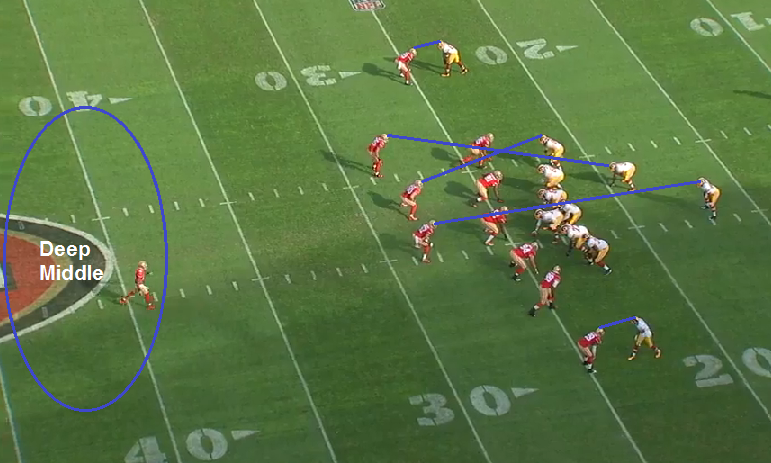


If a WR stays in for additional pass protection, that defender has the option to blitz ('green dog') or play zone (depending on the coverage call).
____________________________________________
Cover 1 Robber - Middle of Field Closed
(man coverage, 1 deep zone, 1 underneath zone)
Strengths:
- all WRs accounted for
- underneath and over the top help defender (safety + robber)
Weaknesses:
- Pick plays
Man coverage with a deep safety and a 'robber' playing the Hook zone. Robber can be any defender, but is mainly a safety or LB.
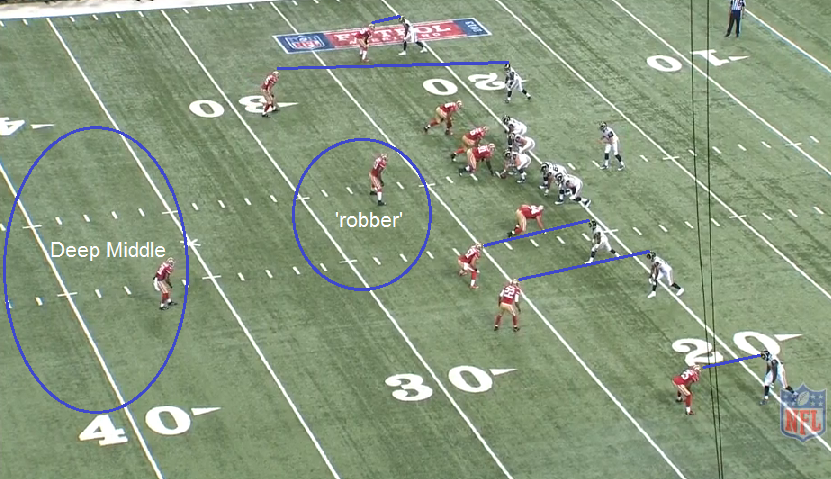
General rule: WR's lined up outside the numbers (near to the sideline) will be played with inside leverage with the sideline used as help. WRs lined up inside the numbers will be played with outside leverage and funneled to the zone defenders in the middle - the safety and the robber defender.
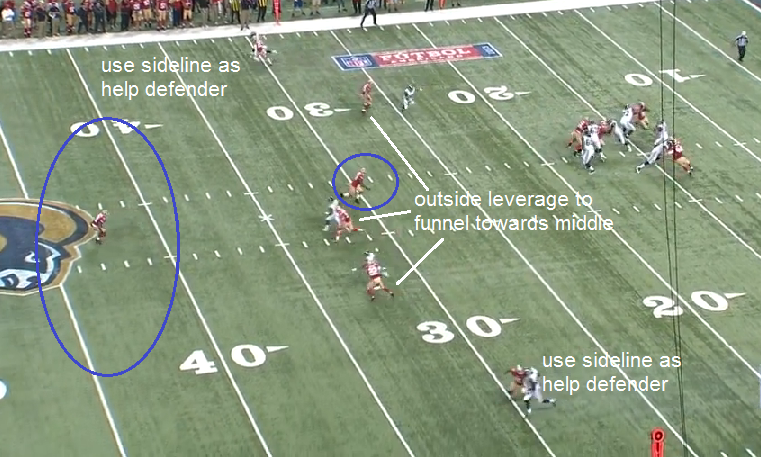

(man coverage, 1 deep zone, 5+ man pressure)
Strengths:
- 5 man blitz pressure
- all WRs accounted for plus a deep safety to help over the top
Weaknesses:
- pick plays
- crossing routes
- QB scrambles



If a WR stays in for additional pass protection, that defender has the option to blitz ('green dog') or play zone (depending on the coverage call).
____________________________________________
Cover 1 Robber - Middle of Field Closed
(man coverage, 1 deep zone, 1 underneath zone)
Strengths:
- all WRs accounted for
- underneath and over the top help defender (safety + robber)
Weaknesses:
- Pick plays
Man coverage with a deep safety and a 'robber' playing the Hook zone. Robber can be any defender, but is mainly a safety or LB.

General rule: WR's lined up outside the numbers (near to the sideline) will be played with inside leverage with the sideline used as help. WRs lined up inside the numbers will be played with outside leverage and funneled to the zone defenders in the middle - the safety and the robber defender.


Apr 24, 2015 at 9:17 AM
- thl408
- Moderator
- Posts: 32,353
Cover 2 Zone - Middle of Field Open
(5 underneath, 2 deep)
Strengths:
- 5 underneath zone defenders
- versus 3 step timing concepts
- CBs can aggressively press WRs; no deep zone responsibility
Weaknesses:
- Only two deep zone defenders
- Large seam down the middle of field, between safeties
- area behind CBs, along sidelines (honey hole)
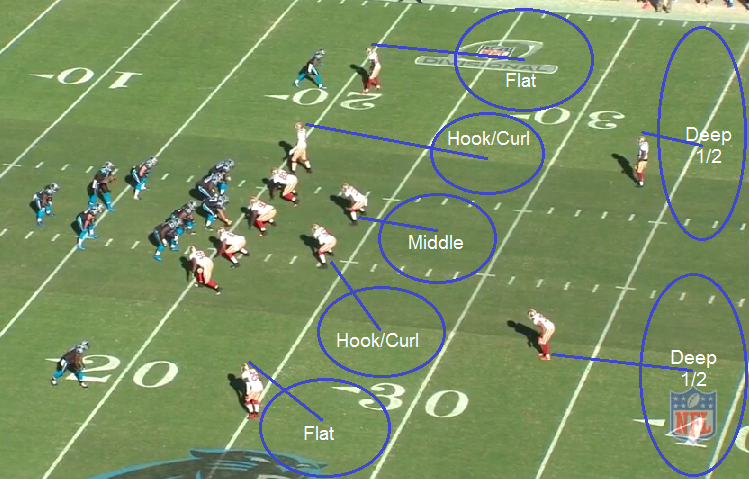

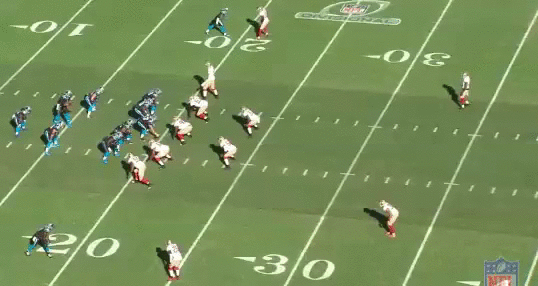
(5 underneath, 2 deep)
Strengths:
- 5 underneath zone defenders
- versus 3 step timing concepts
- CBs can aggressively press WRs; no deep zone responsibility
Weaknesses:
- Only two deep zone defenders
- Large seam down the middle of field, between safeties
- area behind CBs, along sidelines (honey hole)



Apr 24, 2015 at 9:18 AM
- thl408
- Moderator
- Posts: 32,353
Cover 2 Man - Middle of Field Open
(man coverage, 2 deep)
Strengths:
- Can aggressively press WRs knowing there is help over the top
- CBs can get into trail position to defend in/out breaking routes
Weaknesses:
- Large seam between the two deep safeties
- Hard to disguise versus pre-snap motion
- Run support: 7 in the box with safeties aligned deep (15+ yards)
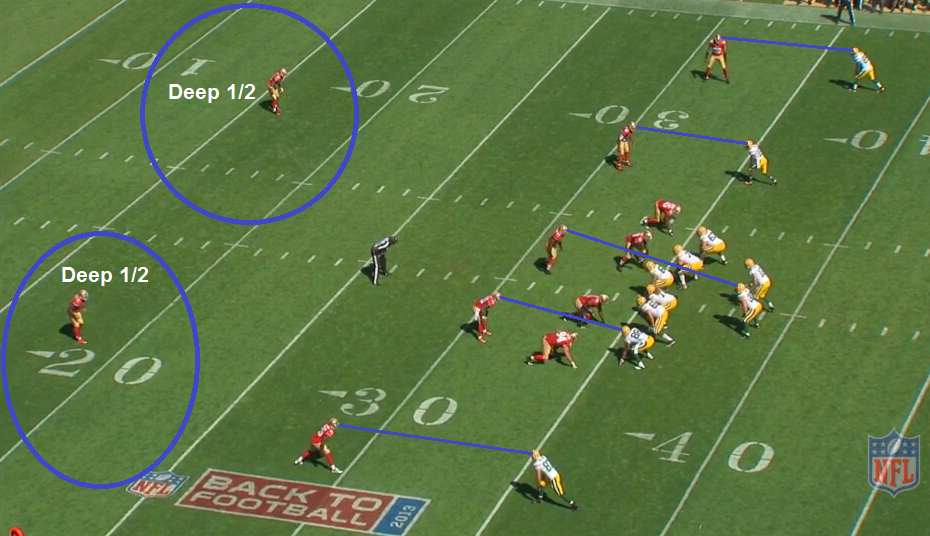
Safeties gain depth to provide over the top coverage. WRs aligned with a plus split (outside the numbers) are funneled towards the sideline. Slot CBs play with inside leverage to protect the middle of the field.
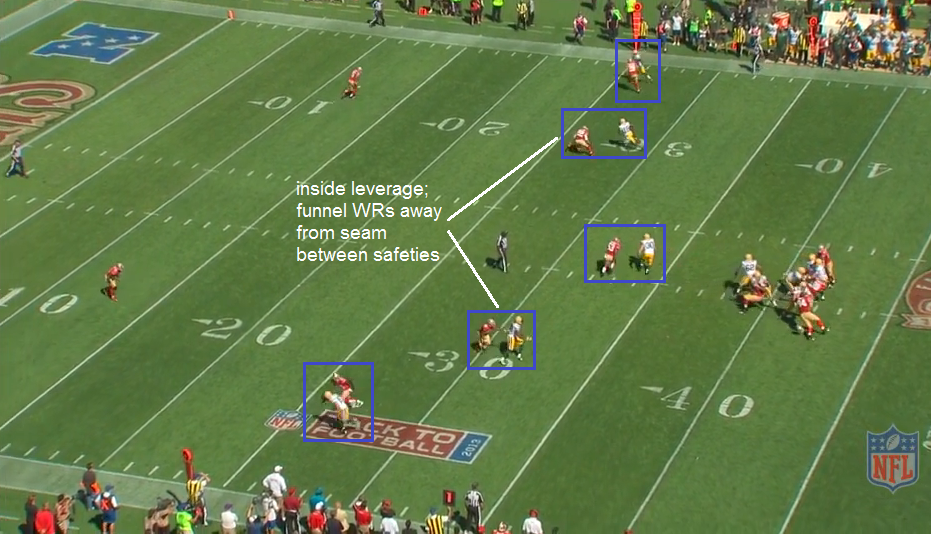
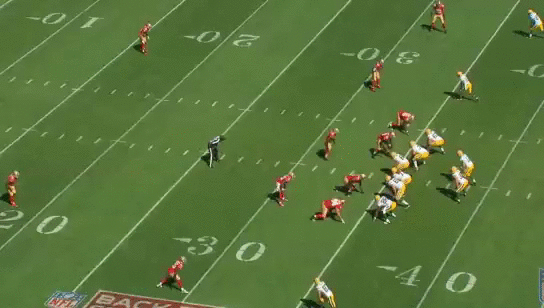
(man coverage, 2 deep)
Strengths:
- Can aggressively press WRs knowing there is help over the top
- CBs can get into trail position to defend in/out breaking routes
Weaknesses:
- Large seam between the two deep safeties
- Hard to disguise versus pre-snap motion
- Run support: 7 in the box with safeties aligned deep (15+ yards)

Safeties gain depth to provide over the top coverage. WRs aligned with a plus split (outside the numbers) are funneled towards the sideline. Slot CBs play with inside leverage to protect the middle of the field.


Apr 24, 2015 at 9:19 AM
- thl408
- Moderator
- Posts: 32,353
Tampa 2 - Middle of Field Closed
(4 underneath zones, 3 deep zones)
Strengths:
- CBs can aggressively press WRs
- Strong pass defense in the flats (CBs)
- 3 deep zone defenders
Weaknesses:
- Middle linebacker assigned to cover a deep zone
- Soft coverage of Hook zones
Tampa2 tries to get the best of both worlds from Cover 2 Zone and Cover 3.
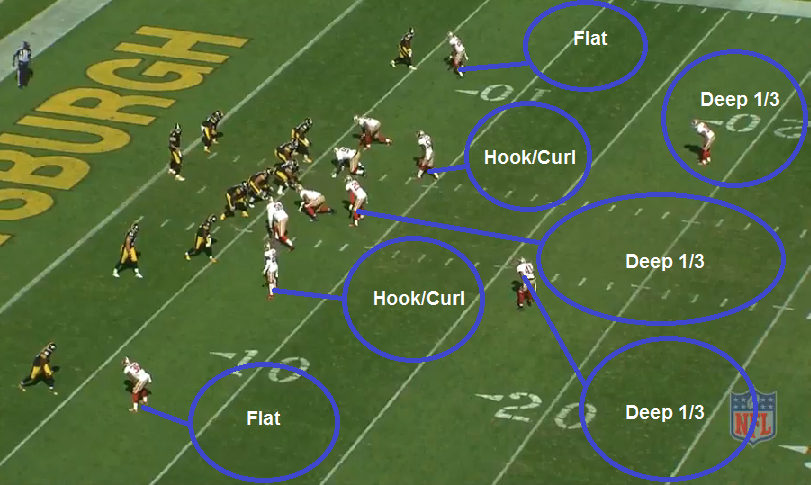
MLB faces the strong side of the passing formation while gaining depth to his middle deep 1/3. Carry any seam routes up the middle.

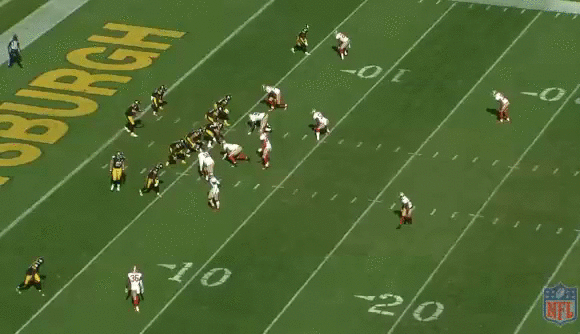
(4 underneath zones, 3 deep zones)
Strengths:
- CBs can aggressively press WRs
- Strong pass defense in the flats (CBs)
- 3 deep zone defenders
Weaknesses:
- Middle linebacker assigned to cover a deep zone
- Soft coverage of Hook zones
Tampa2 tries to get the best of both worlds from Cover 2 Zone and Cover 3.

MLB faces the strong side of the passing formation while gaining depth to his middle deep 1/3. Carry any seam routes up the middle.


Apr 24, 2015 at 9:20 AM
- thl408
- Moderator
- Posts: 32,353
Cover 3 - Middle of Field Closed
(4 underneath zones, 3 deep zones)
Strengths:
- 3 deep zone defenders
- Run defense with 8 in the box
- Ability to creatively rotate coverage from a two deep alignment
Weaknesses:
- Only 4 underneath zone defenders
- Cannot press wideouts because CBs need to bail to their deep third zone
Variations of Cover3:
http://www.49erswebzone.com/forum/niners/182144-all22-analysis-coverages-amp-concepts/page16/#post228
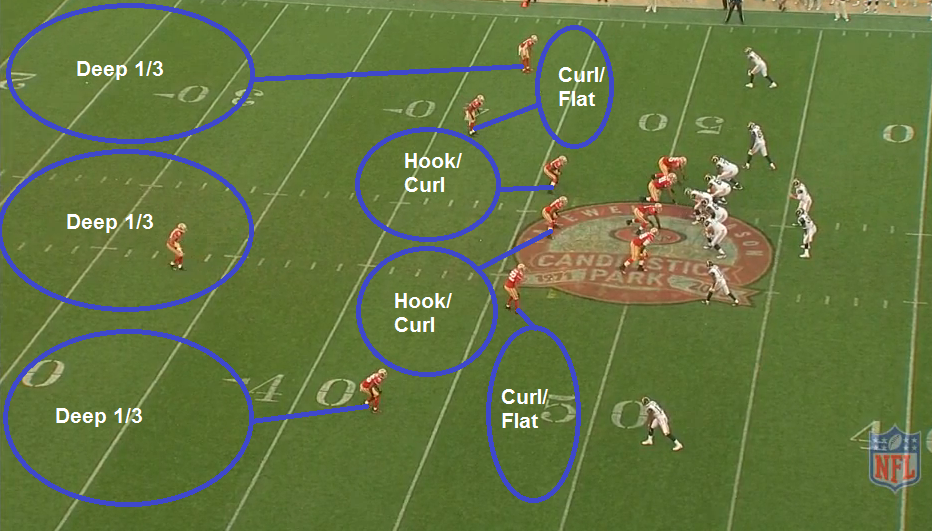
Deep 1/3 defenders stay over the top. Middle safety gains depth to protect any skinny posts into the seams.

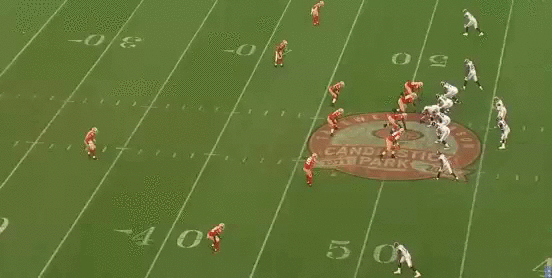
(4 underneath zones, 3 deep zones)
Strengths:
- 3 deep zone defenders
- Run defense with 8 in the box
- Ability to creatively rotate coverage from a two deep alignment
Weaknesses:
- Only 4 underneath zone defenders
- Cannot press wideouts because CBs need to bail to their deep third zone
Variations of Cover3:
http://www.49erswebzone.com/forum/niners/182144-all22-analysis-coverages-amp-concepts/page16/#post228

Deep 1/3 defenders stay over the top. Middle safety gains depth to protect any skinny posts into the seams.


Apr 24, 2015 at 9:27 AM
- thl408
- Moderator
- Posts: 32,353
Cover 4 - Middle of Field Open
(3 underneath zones, 4 deep zones)
Primarily used on long down and distances, but not quite a prevent defense.
Strengths:
- Four deep zone defenders to defend the long pass
Weaknesses:
- Only three underneath zone defenders
Safeties aligned deep. CBs giving a large cushion. (below: 3rd & 25)
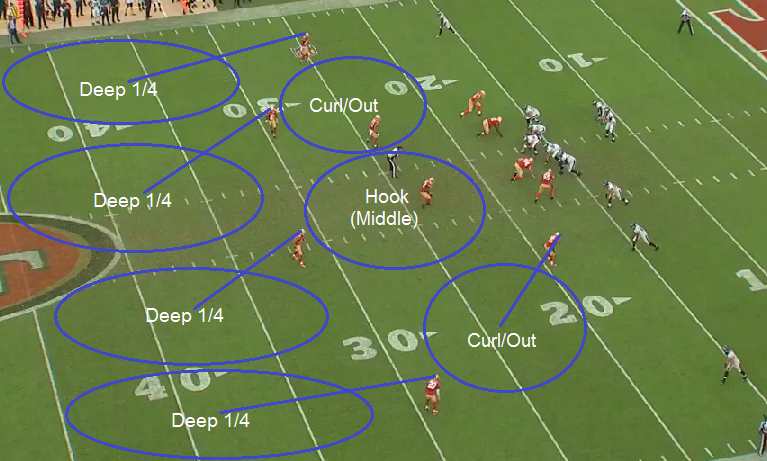
Four deep zone defenders gain depth to maintain a cushion and keep eyes on the play.
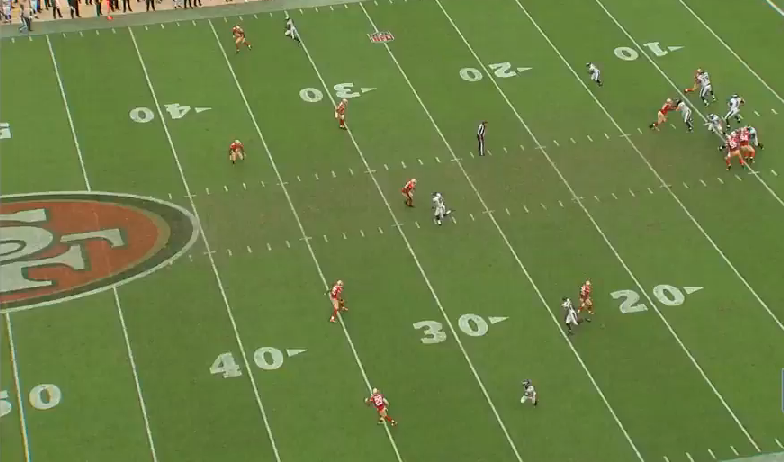
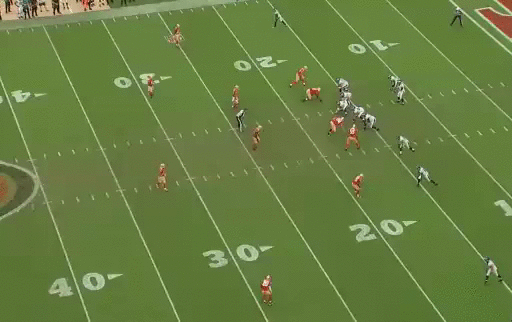
(3 underneath zones, 4 deep zones)
Primarily used on long down and distances, but not quite a prevent defense.
Strengths:
- Four deep zone defenders to defend the long pass
Weaknesses:
- Only three underneath zone defenders
Safeties aligned deep. CBs giving a large cushion. (below: 3rd & 25)

Four deep zone defenders gain depth to maintain a cushion and keep eyes on the play.


Apr 24, 2015 at 12:11 PM
- thl408
- Moderator
- Posts: 32,353
Quarters (and Pattern Matching)
Quarters coverage has a 4 deep shell, but is not a soft (prevent) defense like Cover 4.
Using Pattern Matching, Quarters allows the defense to play differently on each side of the field to help in confusing the QB. Each safety is responsible for making the pre-snap call on his respective side of the field. The different calls, made by the safeties, will adjust to alignment, pre-snap reads, and scouting. There are many articles on Quarters coverage that explain the various ways it can be played. Safeties playing Quarters are often asked to match a WR in 1v1 man coverage.
WRs (route runners) are numbered starting from each sideline, counting up, to the Center. Then the same numbering system is applied on the opposite sideline. The WR closest to the sideline is the #1 WR. Next in is the #2 WR, and so on. This allows pattern matching defenders to apply the rules postsnap.
When describing the depth at which a WR runs a route, the term 'vertical' is a loose term when applied to pattern matching. Depending on the coverage call, down and distance, and scouting of the offense, 'vertical' can mean anywhere between 5-8 yards and higher for any particular play. Vertical can also mean any depth past the linebacker level. When a WR is determined to be going 'vertical', it causes the defense to react accordingly, based on the rules of pattern matching.
Strengths:
- Possible 4 deep zone defenders
- Run defense with a possible 9 in the box (front 7 + 2 safeties)
- Ability to double cover WRs that go deep
- Can be used to play split coverages like Cover6
Weaknesses:
- Play action can get safeties to bite since they are asked to aggressively support the run
- Possible only 3 underneath defenders
- Safety in man coverage
- Late pre-snap motion can confuse pattern match rules
Quarters being played by the left side of defense ("field" side). WRs color highlighted for keeping track. Because #2 and #3 are in a stacked formation, any postsnap crisscrossing will result in change of numbering. Focusing just on the side playing Quarters.
*The colored WRs will remain the same color throughout the play, but his numbering will change.
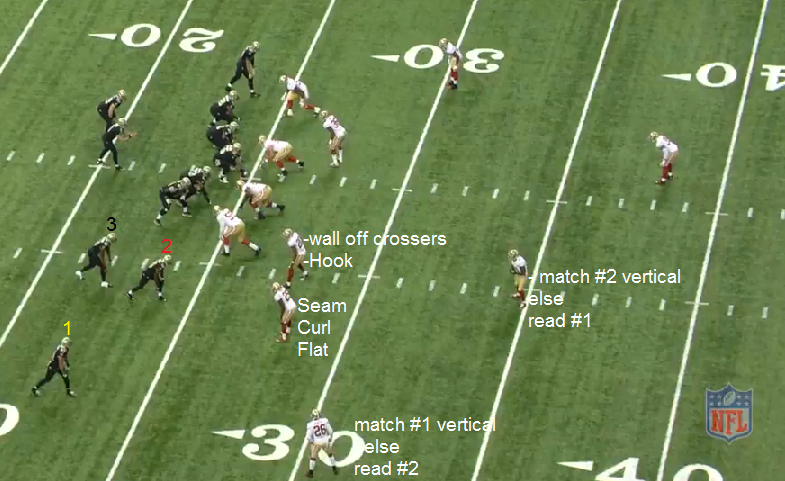
- #2 and #3 crisscross and the defense swaps the numbering of the #2 and #3 WRs. This swapping of numbering allows the pattern match rules to continue to apply. The numbering is used to describe the positioning of the WRs on the field, not by how they were aligned presnap. This prevents pick plays from occurring when CBs follow a preassigned WR, like in man coverage.
- The new #3 crosses shallow and is picked up by the Hook defender.
- The SCF (seam/curl/flat) player will ride the seam to protect the safety from verticals coming his way.
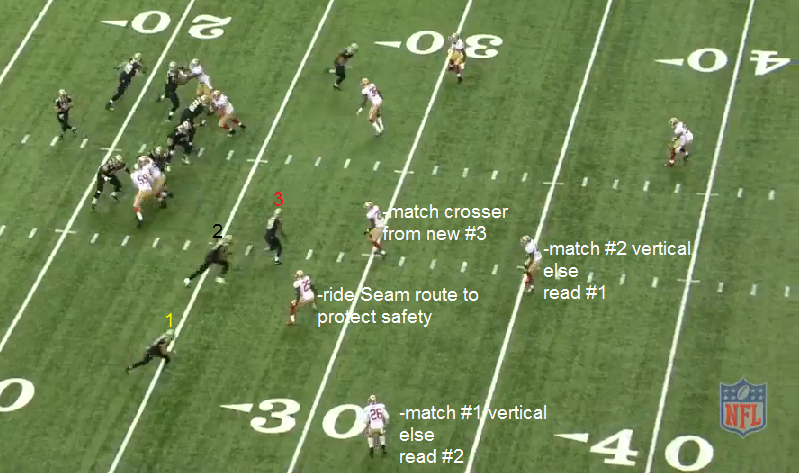
- SCF player: rides the seam then passes off coverage of #2 in order to stay in the Curl zone. Will allow QB's throw to take him to the Flat if there's a threat.
- #2 WR goes vertical, matched by safety
- #1 WR goes vertical, matched by CB
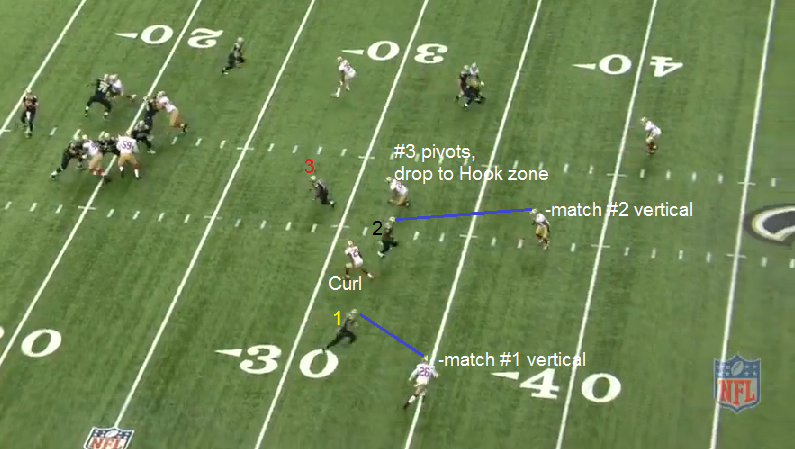

__________________________________________
Quarters: "Box" call to defend the trips bunch formation - 4 defenders vs 3 WRs.
(best guess at the pattern match rules being applied)
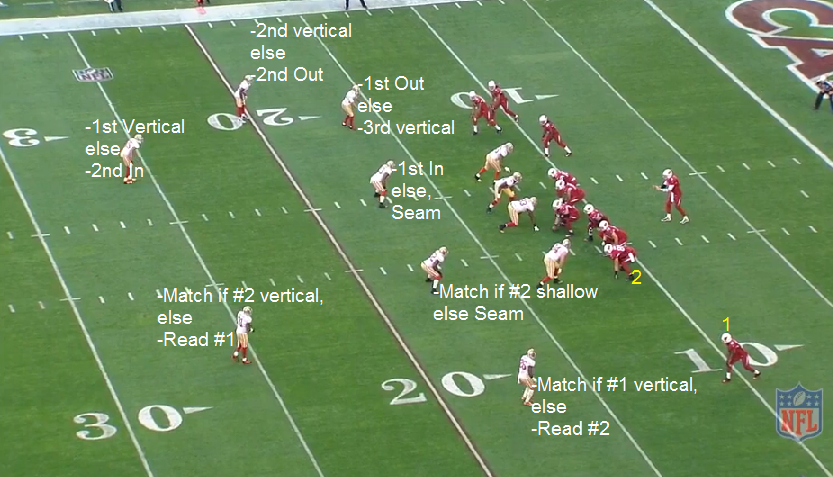
Strongside: WRs are allowed to criss cross. No defender will follow and allow for a pick/rub to occur.
Weakside: #2 chip blocks, is now very unlikely to go vertical. #2 Matched by underneath defender. Safety will now read #1.
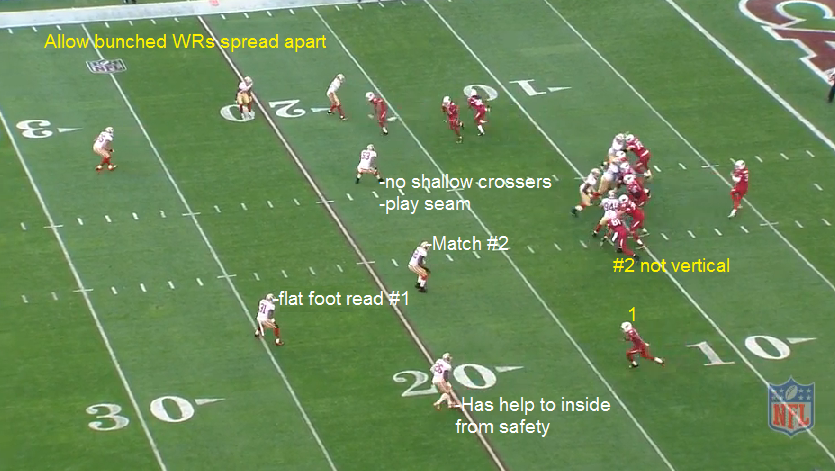
Strongside: Seam player rides any vertical route up the seam to protect deep defenders. 1st Out route is matched. 1st Vertical is identified.
Weakside: bracket coverage on #1
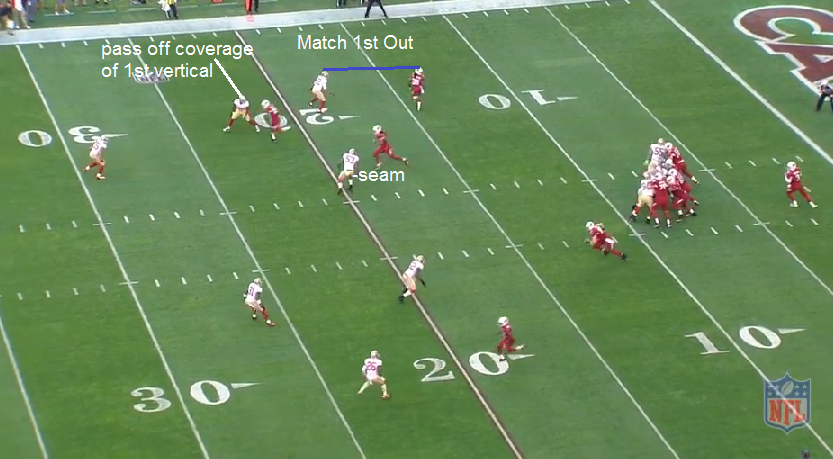
Routes matched
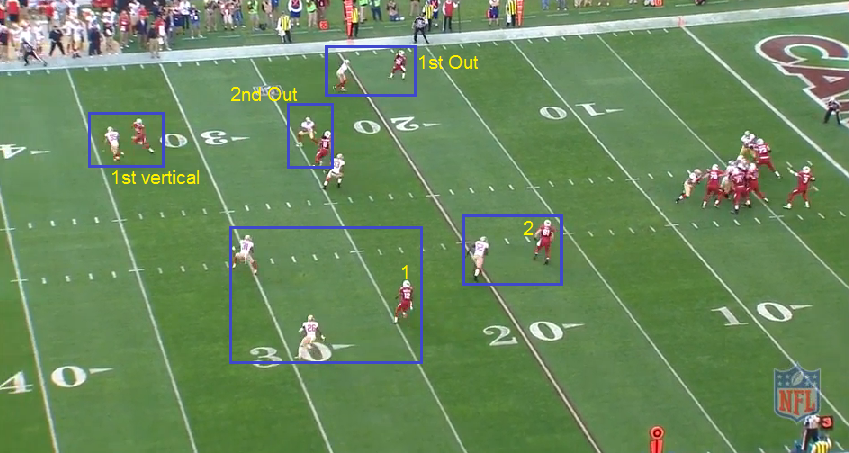
This is a High-Low vertical stretch (zone buster) from a bunch formation (man buster). Both concepts defeated as there is no pick created because the coverage starts off looking like zone coverage. As the route combination develops, the coverage morphs to man coverage and the vertical stretch is not effective.

___________________________
Pattern Matching: (rules shown are best guess)
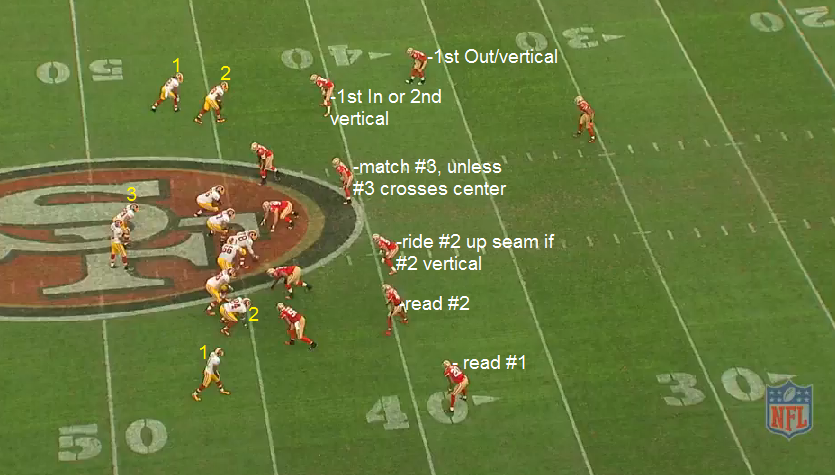
#3 crosses the center and is passed off in coverage by the strongside curl defender, who hears the 'Under' call.
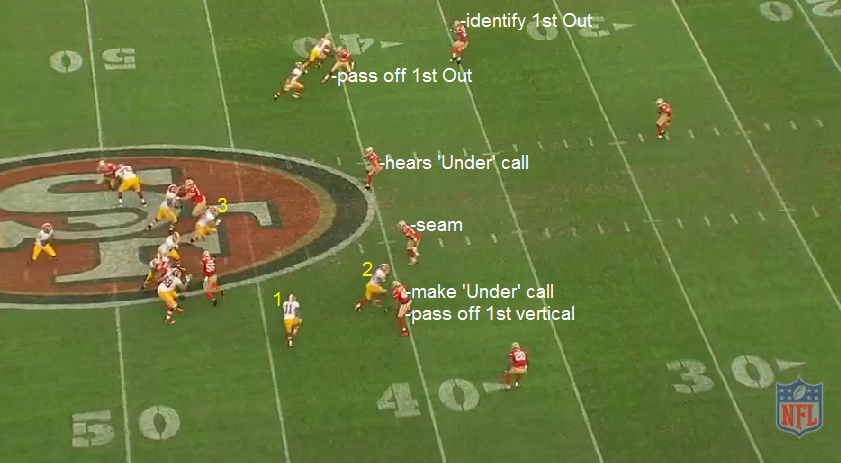
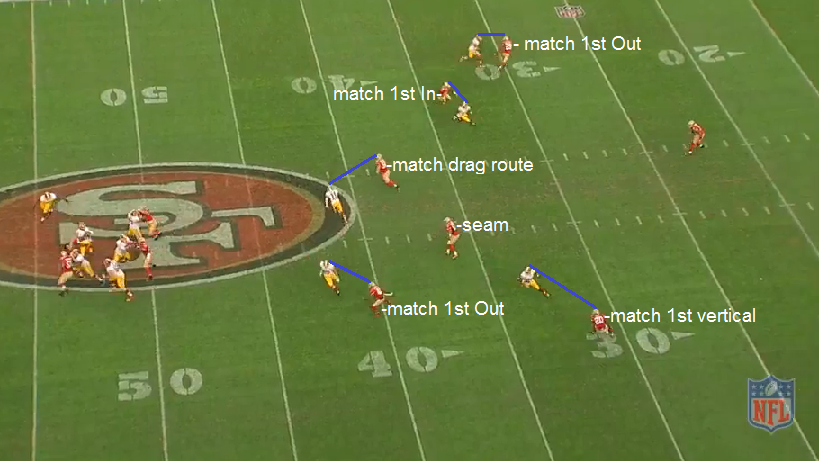
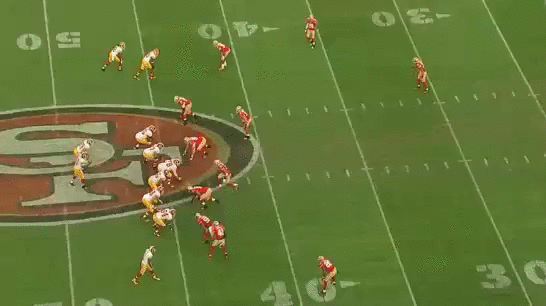
This is how the play unfolds.
- Left side (from offense view): the stacked WRs cross paths to gain separation versus man coverage. CBs did not follow. No pick/rub occurs.
- Right side: red + orange execute the Mesh concept (man coverage buster), but the coverage was in zone coverage at the time; yellow + orange give a high-low read (zone buster), but by then the coverage has changed to man coverage.
The colored defenders are the ones that end up covering the respective colored routes.
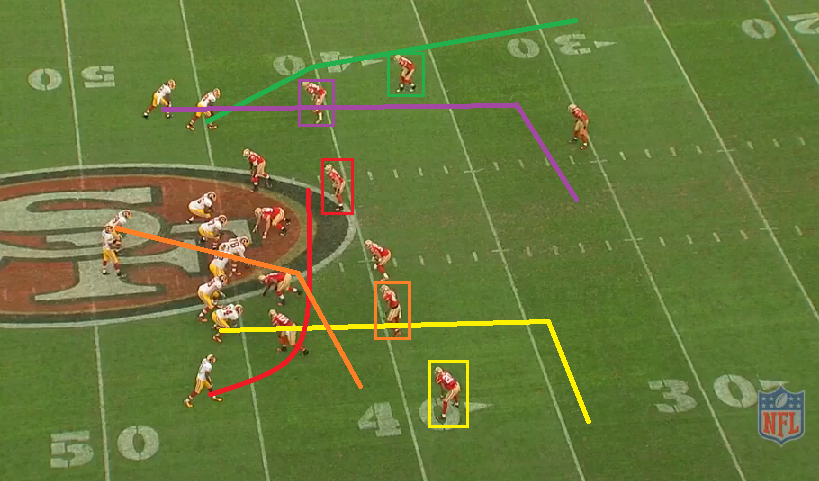
Quarters coverage has a 4 deep shell, but is not a soft (prevent) defense like Cover 4.
Using Pattern Matching, Quarters allows the defense to play differently on each side of the field to help in confusing the QB. Each safety is responsible for making the pre-snap call on his respective side of the field. The different calls, made by the safeties, will adjust to alignment, pre-snap reads, and scouting. There are many articles on Quarters coverage that explain the various ways it can be played. Safeties playing Quarters are often asked to match a WR in 1v1 man coverage.
WRs (route runners) are numbered starting from each sideline, counting up, to the Center. Then the same numbering system is applied on the opposite sideline. The WR closest to the sideline is the #1 WR. Next in is the #2 WR, and so on. This allows pattern matching defenders to apply the rules postsnap.
When describing the depth at which a WR runs a route, the term 'vertical' is a loose term when applied to pattern matching. Depending on the coverage call, down and distance, and scouting of the offense, 'vertical' can mean anywhere between 5-8 yards and higher for any particular play. Vertical can also mean any depth past the linebacker level. When a WR is determined to be going 'vertical', it causes the defense to react accordingly, based on the rules of pattern matching.
Strengths:
- Possible 4 deep zone defenders
- Run defense with a possible 9 in the box (front 7 + 2 safeties)
- Ability to double cover WRs that go deep
- Can be used to play split coverages like Cover6
Weaknesses:
- Play action can get safeties to bite since they are asked to aggressively support the run
- Possible only 3 underneath defenders
- Safety in man coverage
- Late pre-snap motion can confuse pattern match rules
Quarters being played by the left side of defense ("field" side). WRs color highlighted for keeping track. Because #2 and #3 are in a stacked formation, any postsnap crisscrossing will result in change of numbering. Focusing just on the side playing Quarters.
*The colored WRs will remain the same color throughout the play, but his numbering will change.

- #2 and #3 crisscross and the defense swaps the numbering of the #2 and #3 WRs. This swapping of numbering allows the pattern match rules to continue to apply. The numbering is used to describe the positioning of the WRs on the field, not by how they were aligned presnap. This prevents pick plays from occurring when CBs follow a preassigned WR, like in man coverage.
- The new #3 crosses shallow and is picked up by the Hook defender.
- The SCF (seam/curl/flat) player will ride the seam to protect the safety from verticals coming his way.

- SCF player: rides the seam then passes off coverage of #2 in order to stay in the Curl zone. Will allow QB's throw to take him to the Flat if there's a threat.
- #2 WR goes vertical, matched by safety
- #1 WR goes vertical, matched by CB


__________________________________________
Quarters: "Box" call to defend the trips bunch formation - 4 defenders vs 3 WRs.
(best guess at the pattern match rules being applied)

Strongside: WRs are allowed to criss cross. No defender will follow and allow for a pick/rub to occur.
Weakside: #2 chip blocks, is now very unlikely to go vertical. #2 Matched by underneath defender. Safety will now read #1.

Strongside: Seam player rides any vertical route up the seam to protect deep defenders. 1st Out route is matched. 1st Vertical is identified.
Weakside: bracket coverage on #1

Routes matched

This is a High-Low vertical stretch (zone buster) from a bunch formation (man buster). Both concepts defeated as there is no pick created because the coverage starts off looking like zone coverage. As the route combination develops, the coverage morphs to man coverage and the vertical stretch is not effective.

___________________________
Pattern Matching: (rules shown are best guess)

#3 crosses the center and is passed off in coverage by the strongside curl defender, who hears the 'Under' call.



This is how the play unfolds.
- Left side (from offense view): the stacked WRs cross paths to gain separation versus man coverage. CBs did not follow. No pick/rub occurs.
- Right side: red + orange execute the Mesh concept (man coverage buster), but the coverage was in zone coverage at the time; yellow + orange give a high-low read (zone buster), but by then the coverage has changed to man coverage.
The colored defenders are the ones that end up covering the respective colored routes.

Apr 27, 2015 at 11:58 AM
- thl408
- Moderator
- Posts: 32,353
Cover 6 (Middle of Field Open)
Cover 2 on one half of the field + Quarters (variation of Cover4) on the other half of the field. Also called "quarter-quarter-half" due to how the deep zones are divided.
This coverage can be identified by the depth at which the two safeties are playing. The safety playing cover 2 will gain depth at the snap, sometimes aligning with more depth pre-snap.
Where the ball is placed on the field can determine which side of the field plays cover 2 and which side plays Quarters. Since the Cover2 safety has more area of responsibility, he is protected by being given the short (boundary) side of the field - determined by ball placement on the hash marks. The wide (field) side of the field will play Quarters since there are two DBs, each covering deep 1/4.
Strengths:
- Split coverage can confuse the offense
- good run support to Quarters side safety
- good flat support from Cover2 side CB (if playing zone)
Weaknesses:
- Quarters side flat area
- Playaction can get Quarters side safety to bite
Quarters side: Pattern Match rules shown (best guess).
Cover 2 side: Because the WR at the top of the screen is lined up with the plus split, a pre-snap call is made to man cover the WR.

Quarters side: #2 goes shallow across the field. This frees up the Quarters safety to read #1. The 'Under' call is made, which puts the defender on the other side of the field on alert.

Because no defender follows #2 on the drag route, no pick/rub occurs. #1 goes vertical and gets bracketed.

The pick/rub (a man coverage busting concept) is defeated with the 'Under' call.

Cover 2 on one half of the field + Quarters (variation of Cover4) on the other half of the field. Also called "quarter-quarter-half" due to how the deep zones are divided.
This coverage can be identified by the depth at which the two safeties are playing. The safety playing cover 2 will gain depth at the snap, sometimes aligning with more depth pre-snap.
Where the ball is placed on the field can determine which side of the field plays cover 2 and which side plays Quarters. Since the Cover2 safety has more area of responsibility, he is protected by being given the short (boundary) side of the field - determined by ball placement on the hash marks. The wide (field) side of the field will play Quarters since there are two DBs, each covering deep 1/4.
Strengths:
- Split coverage can confuse the offense
- good run support to Quarters side safety
- good flat support from Cover2 side CB (if playing zone)
Weaknesses:
- Quarters side flat area
- Playaction can get Quarters side safety to bite
Quarters side: Pattern Match rules shown (best guess).
Cover 2 side: Because the WR at the top of the screen is lined up with the plus split, a pre-snap call is made to man cover the WR.

Quarters side: #2 goes shallow across the field. This frees up the Quarters safety to read #1. The 'Under' call is made, which puts the defender on the other side of the field on alert.

Because no defender follows #2 on the drag route, no pick/rub occurs. #1 goes vertical and gets bracketed.

The pick/rub (a man coverage busting concept) is defeated with the 'Under' call.

May 6, 2015 at 10:01 PM
- thl408
- Moderator
- Posts: 32,353
Fire Zone Blitz (Middle of Field Closed; 5 man pressure, 3 underneath zones, 3 deep)
Most blitz packages are supported with man coverage in the defensive backfield. The Fire Zone blitz uses zone coverage on the backend with 6 zone defenders. Inspired by Bill Arnsparger and perfected by HoF coach Dick LeBeau, the zone blitz can also have pattern matching principles added to provide a best of all worlds defensive call. It's conception was from the goal to achieve "safe pressure" - to blitz, but not get burned with a big play.
Strengths:
- 5 man pressure
- 3 deep coverage
- Ability to overload one side of the offensive line (and drop a lineman back into zone coverage to rob the hot route)
Weaknesses:
- 3 underneath zone defenders
- run defense on the side where defensive lineman is dropping back into coverage
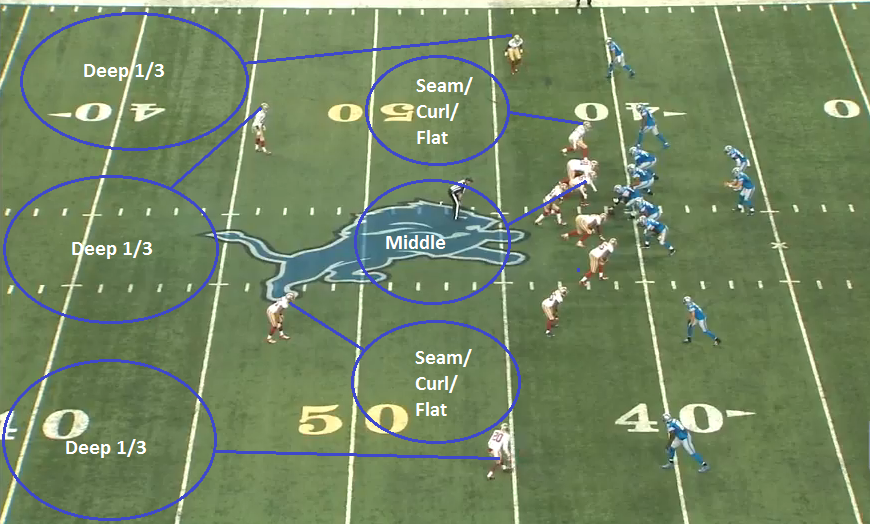
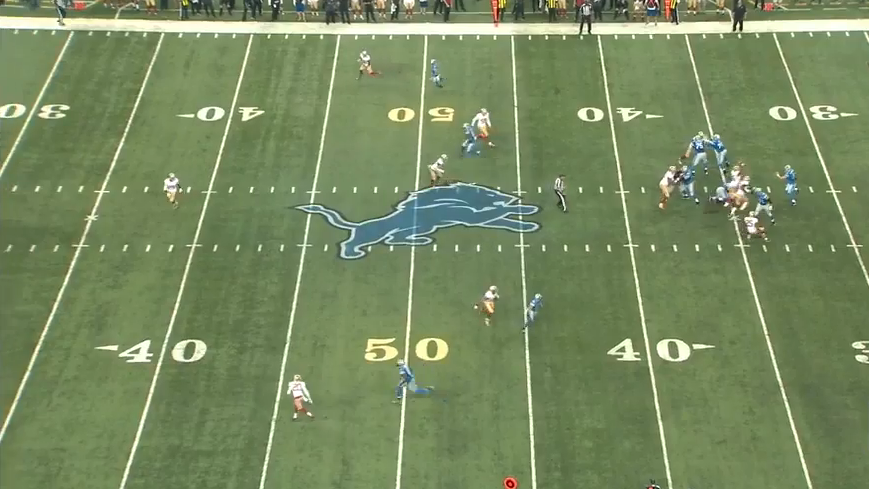
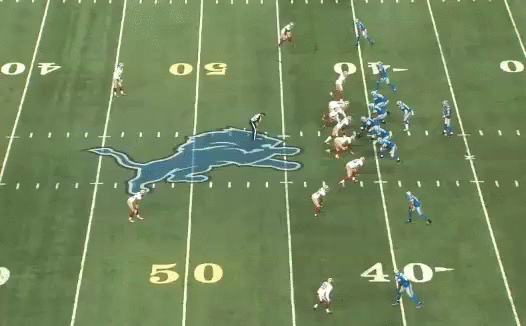
Most blitz packages are supported with man coverage in the defensive backfield. The Fire Zone blitz uses zone coverage on the backend with 6 zone defenders. Inspired by Bill Arnsparger and perfected by HoF coach Dick LeBeau, the zone blitz can also have pattern matching principles added to provide a best of all worlds defensive call. It's conception was from the goal to achieve "safe pressure" - to blitz, but not get burned with a big play.
Strengths:
- 5 man pressure
- 3 deep coverage
- Ability to overload one side of the offensive line (and drop a lineman back into zone coverage to rob the hot route)
Weaknesses:
- 3 underneath zone defenders
- run defense on the side where defensive lineman is dropping back into coverage



May 6, 2015 at 10:01 PM
- thl408
- Moderator
- Posts: 32,353
.
May 6, 2015 at 10:02 PM
- thl408
- Moderator
- Posts: 32,353
Cornerback Technique
- a CB can 'shade' towards a WR's inside or outside shoulder during the presnap alignment, or be head on (no shade).
- 'Leverage' is used to describe which side of the WR that the CB is favoring during the play. A CB's leverage can help him funnel the WR towards help coverage.
- 'Position' is used to indicate whether the CB is trailing or over-the-top of the WR.
- a CB can also align in 'press' or 'off coverage' alignment. A CB's pre-snap alignment does not necessarily indicate whether he will play man or zone coverage.
When in man coverage, the coverage shell and the WR's split can determine what shade and leverage the CB wants to play with.
Press, Bump and Run
Strengths:
- disrupt timing routes
- great jam at the line of scrimmage can completely defeat a route
Weaknesses:
- poor run/pass read because eyes are locked on WR
- missed jam can result in immediate separation
WR is in a 'reduced' split as he lines up inside the numbers on the field (very far from the sideline). Aligned with an outside shade, he wants the WR to have a difficult time getting an outside release.



Trail position with outside leverage is the correct positioning to funnel the WR to the Cover 1 safety, who is providing help over-the-top, to the inside.

The WR is essentially bracketed by the CB and the safety. When the WR tries to break the route to the outside, the CB's outside leverage defeats the route.

_________________
Press, Mirror
Strengths:
- Very little separation for the first moments after the snap due to being close at the LoS with no risk of losing on an attempt to jam (bump)
Con:
- Poor run/pass read with eyes locked on WR
Aligned in press, but not tight at line of scrimmage. WR in a 'plus' split outside the numbers on the field (close to sideline).
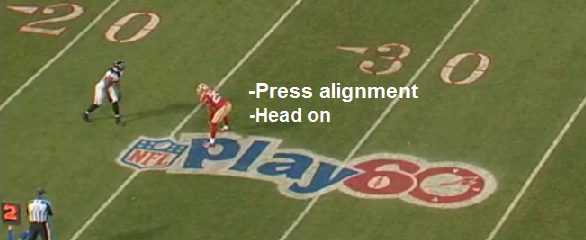
No attempt to jam. Due to the WR's plus split, the CB takes inside leverage and will use the sideline as a help defender.
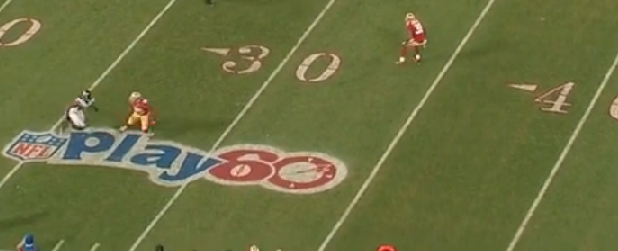
Eyes locked on WR, mirroring his every step. Impede the WR's route by staying in his face.

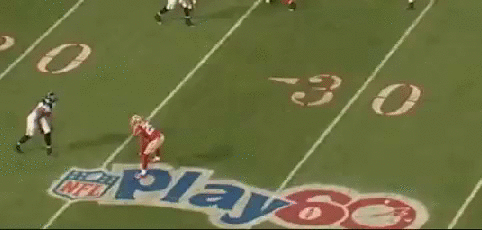
_______________________
Off Coverage
Strengths:
- good run/pass read due to ability to watch the QB
- can break downhill on 3 step timing routes
- helps to defeat vertical routes
- can disguise man or zone coverage
Weaknesses:
- clean release for WR
- susceptible to pump fakes due to watching QB
- WR screens
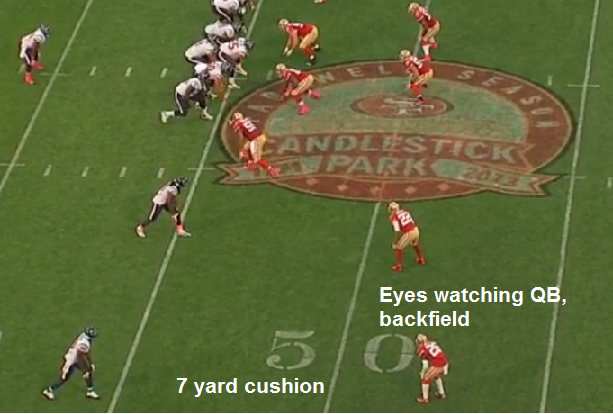
Allow WR to slowly close cushion and watch the QB through any 3/5 step concepts. If QB is seen opening his shoulders up to throw, break on the route.
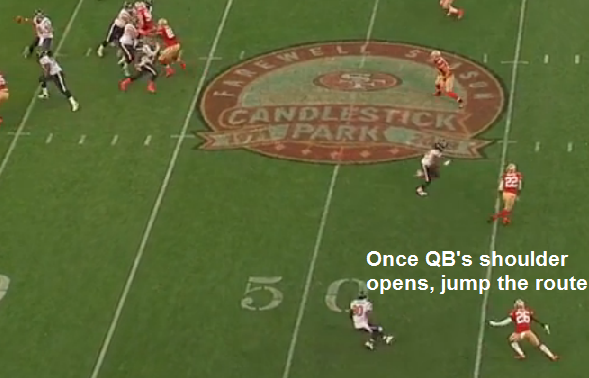
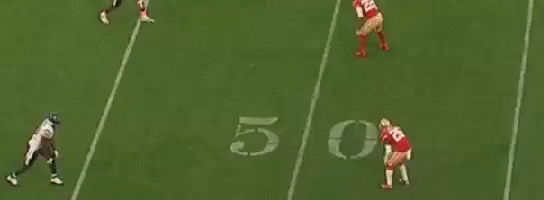
_____________________
Bail
Strengths:
- helps defeat deep vertical routes
- good run/pass read
Weakness:
- In/Out breaking routes
CB can align in press or off coverage.

At the snap, the CB opens hips to turn upfield while facing the play.

Vertical route defeated

- a CB can 'shade' towards a WR's inside or outside shoulder during the presnap alignment, or be head on (no shade).
- 'Leverage' is used to describe which side of the WR that the CB is favoring during the play. A CB's leverage can help him funnel the WR towards help coverage.
- 'Position' is used to indicate whether the CB is trailing or over-the-top of the WR.
- a CB can also align in 'press' or 'off coverage' alignment. A CB's pre-snap alignment does not necessarily indicate whether he will play man or zone coverage.
When in man coverage, the coverage shell and the WR's split can determine what shade and leverage the CB wants to play with.
Press, Bump and Run
Strengths:
- disrupt timing routes
- great jam at the line of scrimmage can completely defeat a route
Weaknesses:
- poor run/pass read because eyes are locked on WR
- missed jam can result in immediate separation
WR is in a 'reduced' split as he lines up inside the numbers on the field (very far from the sideline). Aligned with an outside shade, he wants the WR to have a difficult time getting an outside release.



Trail position with outside leverage is the correct positioning to funnel the WR to the Cover 1 safety, who is providing help over-the-top, to the inside.

The WR is essentially bracketed by the CB and the safety. When the WR tries to break the route to the outside, the CB's outside leverage defeats the route.

_________________
Press, Mirror
Strengths:
- Very little separation for the first moments after the snap due to being close at the LoS with no risk of losing on an attempt to jam (bump)
Con:
- Poor run/pass read with eyes locked on WR
Aligned in press, but not tight at line of scrimmage. WR in a 'plus' split outside the numbers on the field (close to sideline).

No attempt to jam. Due to the WR's plus split, the CB takes inside leverage and will use the sideline as a help defender.

Eyes locked on WR, mirroring his every step. Impede the WR's route by staying in his face.


_______________________
Off Coverage
Strengths:
- good run/pass read due to ability to watch the QB
- can break downhill on 3 step timing routes
- helps to defeat vertical routes
- can disguise man or zone coverage
Weaknesses:
- clean release for WR
- susceptible to pump fakes due to watching QB
- WR screens

Allow WR to slowly close cushion and watch the QB through any 3/5 step concepts. If QB is seen opening his shoulders up to throw, break on the route.


_____________________
Bail
Strengths:
- helps defeat deep vertical routes
- good run/pass read
Weakness:
- In/Out breaking routes
CB can align in press or off coverage.

At the snap, the CB opens hips to turn upfield while facing the play.

Vertical route defeated

May 6, 2015 at 10:02 PM
- thl408
- Moderator
- Posts: 32,353
Defense